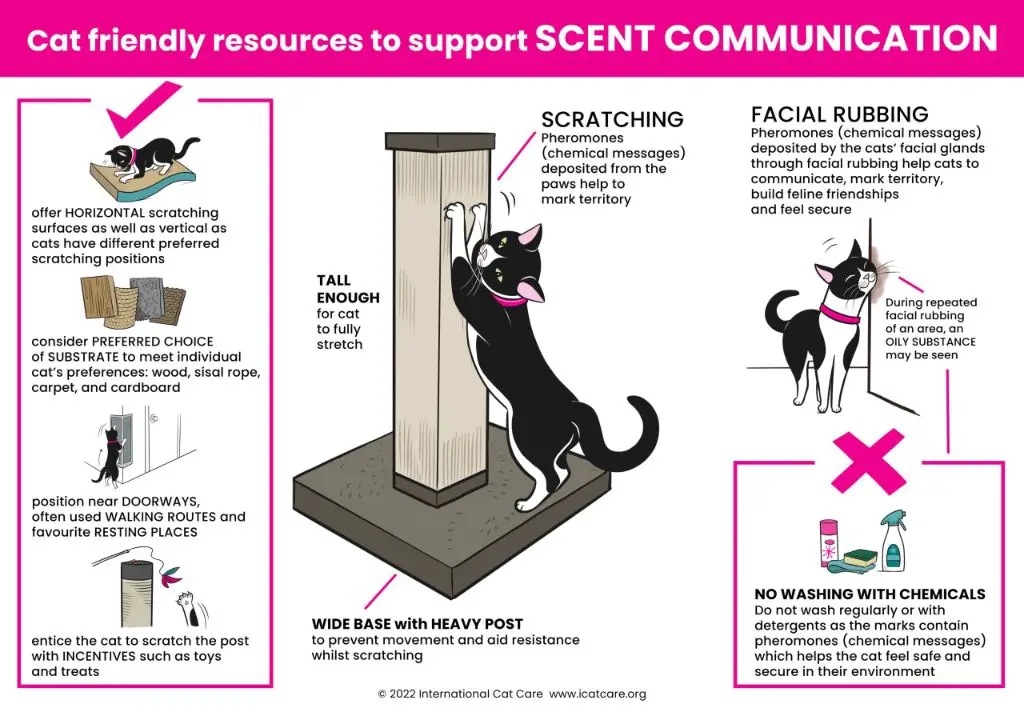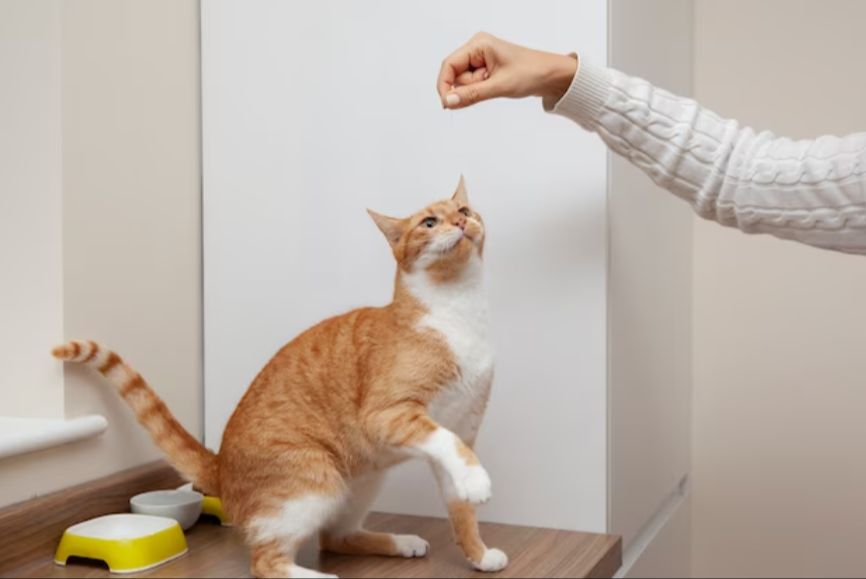Understand Why Cats Jump on Counters
Cats jump on counters for a variety of reasons rooted in their natural instincts and behaviors. According to certified feline behavior consultant Ingrid Johnson, “The cats’ motivation to get on the kitchen counter is usually one of two things.” (https://slate.com/human-interest/2019/02/cats-jump-on-kitchen-countertops-stop-them-pet-advice.html)
First, cats have a natural instinct to seek high vantage points in order to survey their territory. Counters and tables allow them to perch up high to get the lay of the land and look out for potential threats.
Second, cats may jump on counters for attention and playtime. They know their owners frequent these spaces and will often hop up for some interaction. This is especially true for energetic young cats seeking stimulation.
Additionally, cats are curious creatures by nature and will explore new environments by jumping on surfaces like counters. And the smells of human food can entice cats to check out counters and tables at mealtimes.
Provide Appropriate Alternatives

One effective way to keep cats from jumping on counters is to provide them with appropriate alternative surfaces and activities. This gives them other options to satisfy their desire to climb and explore.
Cat trees, shelves, and perches set up around the home can provide cats with climbing surfaces and high vantage points. Make sure to place cat trees near windows for birdwatching or in high-traffic areas so your cat feels part of the action. Shelves mounted on walls give cats a place to perch up high and survey their domain.
Interactive toys that cats can bat, chase, and pounce on are also important, according to This Old House (https://www.thisoldhouse.com/home-finances/reviews/how-to-keep-cats-off-counters). Schedule daily play sessions to engage your cat’s natural hunting instincts. Toys like feather wands and laser pointers that encourage jumping and running can help burn off energy that might otherwise go into counter surfing.
Providing appropriate outlets for natural cat behaviors can reduce their temptation to jump on kitchen counters in search of stimulation.
Use Deterrents
There are several deterrents you can use to discourage your cat from jumping on counters:
Double-sided tape – Place strips of sticky double-sided tape on the counter edges. Cats dislike the stickiness on their paws and will avoid areas with tape. Replace the tape frequently as dust and dirt decrease its stickiness. Rover.com recommends double-sided tape as an effective counter deterrent.
Tin foil or plastic mats – Cover counters with sheets of crinkly tin foil or upside-down plastic carpet/runner mats with the spike side up. The noise and texture surprise cats when they try to jump up. Reapply after cleaning the counters. Apartment Therapy notes this works best for curious kittens exploring counters for the first time.
Scat mats – Scat mats deliver a static shock when stepped on, which startles cats but is harmless. Place mats on countertops or cover the entire counter when not in use. Remember to remove them before use to avoid shocking yourself. Mats may need to be taped down initially before cats learn to avoid them.
Motion-activated devices – Devices like Ssscat spray cans, the PetSafe SSSCat deterrent, and Ultrasonic repellers sense motion and emit bursts of compressed air, water, or ultrasonic sound. They startle cats when movement is detected on countertops. Remember to remove them before use to avoid getting sprayed or startled yourself.
Remove Rewards

One of the best ways to discourage cats from jumping on counters is to remove any rewards they get from doing so. As per this video, cats are often motivated to jump on counters because they have gotten food or attention there in the past. To curb this behavior:
- Keep human food, pet food, water bowls, and other tempting items off countertops and completely out of reach of your cat.
- Never give your cat any attention, such as petting, talking to, or playing with them when they are on the counter. Completely ignore them until they jump down.
By removing all rewards your cat associates with being on the counter, you can make the behavior unrewarding and reduce their desire to jump up there. Be vigilant and consistent about removing all rewards every single time.
Create Barriers
One effective way to keep cats off counters is by creating physical barriers that block access. Some options to consider include:
Baby gates – Installing a baby gate or pet gate across an open doorway leading to the kitchen can prevent cats from freely entering the room and jumping on counters. Make sure the gate is tall enough that cats cannot easily jump over it. Some retractable pet gates allow the gate to be opened when needed. (Source)
Plastic protectors for edges – There are plastic protectors available that affix to the edge of counters with adhesive. The surface is slippery, so when a cat tries to jump up onto the counter, they slide off. This creates an undesirable experience that deters cats from jumping up. (Source)
Shelves or obstacle blocks – Placing shelves, stools, or other items close to the counter can physically block a cat from being able to jump up. You can also affix shelving above counters to eliminate the open space cats use to jump. Just be sure any items are securely installed so they cannot fall on pets. (Source)
Use Aversives
Aversives are things cats want to avoid or find unpleasant. Using them can help deter cats from jumping on counters.
Citrus or mint scents are two aversives you can try. Cats tend to dislike these strong smells. Apply citrus or mint essential oils, sprays, or peels to areas of the counter you want to keep your cat off of. Just be sure to research which extracts and oils are safe for cats before using (https://felinebehaviorsolutions.com/counter-surfing-cats/).
Another aversive is a pet corrector, a device that emits a loud hissing noise when activated. The noise startles cats and deters them from the area. Spray a pet corrector in the direction of the counter when you catch your cat jumping up. Eventually, just seeing the pet corrector may deter them. However, be cautious not to overuse pet correctors as they can increase a cat’s overall anxiety (https://www.felinepurrspective.com/strategies-for-counter-surfing-cats/).
Try Remote Punishers
Remote punishers can deter cats from jumping on counters without direct human involvement. These devices activate when the cat jumps on a surface and provide an unpleasant stimulus to discourage the behavior. Some options include:
Motion-activated noise makers: Place these on the countertop and they emit a loud sound when detecting motion, startling the cat (VCA Hospitals). This remote punishment interrupts the rewarding experience of being on the counter.
Motion-activated air spray: An air canister device detects cat motion on counters and sprays a quick, harmless burst of air. This scares cats off surfaces without harming them (PAWS). It operates as a remote punisher even when owners aren’t present.
Motion-activated water spray: Similar devices detect a cat’s presence and spray water. The sudden spray surprises cats and deters them from jumping up (PAWS). It punishes the behavior without direct human involvement.
Remote-controlled hissing device: This manually operated device emits an unpleasant hissing noise to startle cats off counters from a distance (VCA Hospitals). Owners can deploy the sound as a remote punisher without approaching the cat.
Use Booby Traps
Booby traps can provide an effective deterrent for cats jumping on counters (DDFL). One simple but effective booby trap is balancing empty soda cans filled with a few pennies on the counter edges. When the cat jumps up, the cans fall and make a loud noise that will startle them. Just be sure the cans won’t fall on the cat and hurt them. You can also stack plastic cups on the counter edges so they fall and make noise when knocked over. The loud noises act as remote punishers that deter the cat from jumping up again (SSPCA).
Other more advanced booby traps like the ScatMat use mild but harmless static shocks to startle cats when stepped on. Products like the X-mat emit high frequency sounds when triggered that cats strongly dislike. Automated spray deterrents like the SSSCAT detect motion and spray bursts of air to scare cats away (PetPooSkidoo). While effective, these gadgets can be more expensive than simple DIY traps. Start with cans and cups first before investing in commercial cat deterrents.
Consider Pheromones
One way to help deter cats from jumping on counters is to use synthetic pheromones like Feliway or Comfort Zone. These products contain synthetic versions of feline facial pheromones that can help relieve stress and anxiety in cats. When sprayed around problem areas, they can have a calming effect and reduce undesirable behaviors.

Specifically, Feliway and Comfort Zone contain synthetic versions of the feline facial pheromone F3, which cats deposit when they rub their cheeks on objects. This leaves their scent and marks the area as safe. The synthetic pheromones mimic this facial marking, signaling to the cat that the area is familiar and safe. This can reduce their urge to jump on counters to explore and mark territory.
While synthetic pheromones alone usually aren’t enough to fully stop counter surfing, they are helpful as part of a broader counter-conditioning approach. When used consistently alongside other aversive techniques like double-sided tape, the pheromones can help take the edge off a stressed cat and support other training.
Pheromone diffusers should be placed near common problem areas, like next to the kitchen counter or near cat feeding stations. Doing this over several weeks can help recondition a cat against jumping up. However, it’s important to also use other deterrents so the cat doesn’t still get rewarded for counter surfing in the meantime.
Be Consistent
Consistency is key when trying to teach your cat to stay off the counter. Every family member who interacts with your cat must follow the training regimen. Set clear rules and stick to them. If one person lets the cat on the counter while another shoos them off, the cat will become confused.

Make sure to reinforce wanted behaviors like sitting calmly on the floor, as this will encourage your cat to keep all 4 paws down. Give treats, playtime rewards or affection when your cat chooses an appropriate spot.
Never use physical punishment like hitting or yelling. This will only make your cat afraid and lead to more problematic behaviors down the line. Stay positive and be consistent.
